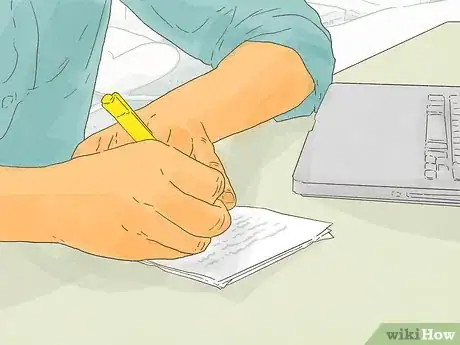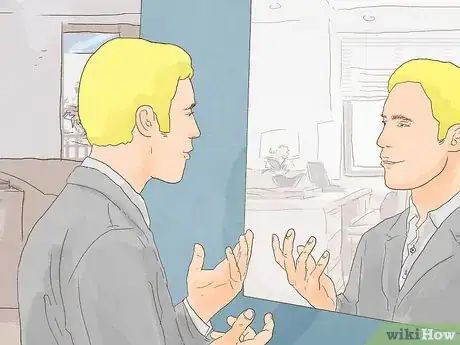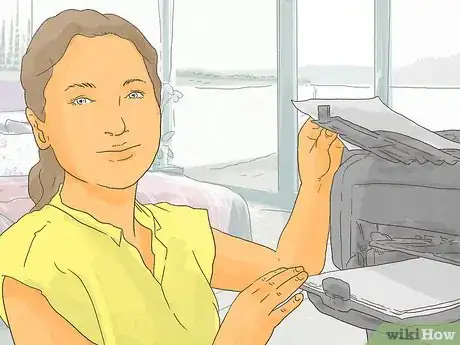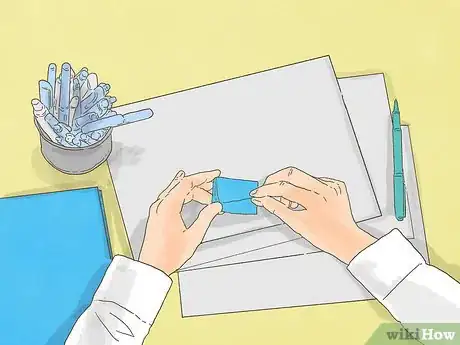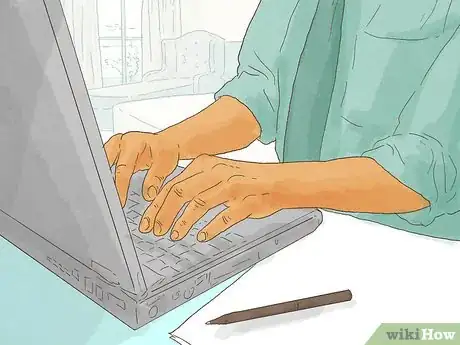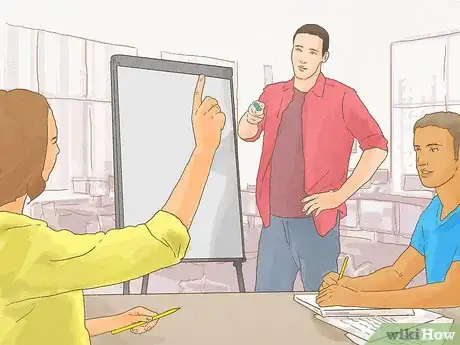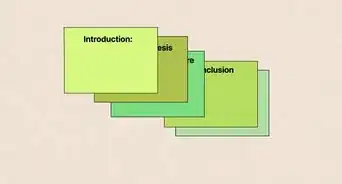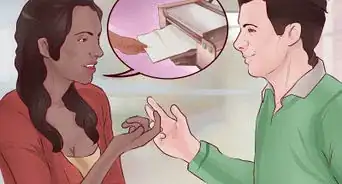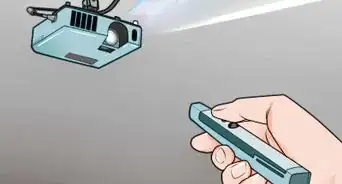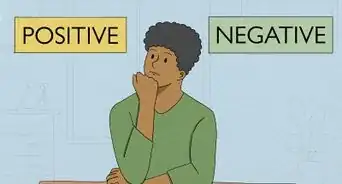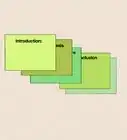This article was co-authored by Meredith Juncker, PhD. Meredith Juncker is a PhD candidate in Biochemistry and Molecular Biology at Louisiana State University Health Sciences Center. Her studies are focused on proteins and neurodegenerative diseases.
wikiHow marks an article as reader-approved once it receives enough positive feedback. In this case, 80% of readers who voted found the article helpful, earning it our reader-approved status.
This article has been viewed 44,157 times.
After creating a science project, you’ll likely have to present your work to your class or at a science fair. Try to give yourself a few weeks to plan and put together your presentation. Outline your main points, make note cards, and practice ahead of time. Make a clear, neat display board or PowerPoint presentation. When it comes time to present, relax, speak clearly and loudly, and avoid reading your presentation word for word.
Steps
Putting Together Your Presentation
-
1Start planning your presentation early. The longer you have to prepare, the more comfortable you’ll be when you make your presentation. Try to start a few weeks before the day you present your project.[1]
- Finish up your experiment, research, and other aspects of your project.
- Get the materials you’ll need for your display board.
- Start to imagine how you’ll organize your information.
-
2Make an outline. Your outline should lay out the skeleton of your presentation. It should include these elements:
- An introduction to your topic or the problem you’ve addressed.
- How the problem impacts the real world (such as how a better understanding of the issue can impact humans).
- Your hypothesis, or what you expected to learn about through your experiment.
- The research you did to learn more about your topic.
- The Materials that you used in your project.
- Each step of your experiment’s procedure.
- The results of your experiment.
- Your conclusion, including what you learned and whether your data supports your hypothesis.
Advertisement -
3Consider writing out your presentation. While you should avoid reading your presentation word for word, it’s a good idea to write out what you want to say. Writing your presentation will help you make sure you communicate clearly and avoid grammar mistakes.[2]
- When writing your speech, try to keep it simple, and avoid using phrases that are more complicated than necessary. Try to tailor the presentation to your audience: will you be presenting to your class, judges, a higher grade than yours, or to an honors class?
- Writing out your presentation can also help you manage your time. For example, if you’re supposed to talk for less than five minutes, shoot for less than two pages.
-
4Create notecards. It’s a good idea to make note cards with your presentation’s main points. However, keep in mind presentations are often scored based on your ability to speak about your topic without reading a report word for word. Use your notecards primarily to help you practice your presentation and keep them on hand to make sure your presentation stays on subject.
-
5Plan your demonstration. Demonstrating your experiment or your research topic can help engage your audience with a visual example. If your presentation involves making a demonstration, practice it several times in advance to be sure everything goes as planned.
- For example, if you've made a volcano, make sure you know the exact mix of chemicals that will create the eruption.
-
6Practice making your presentation. First, practice by yourself or in a mirror. If you have a time limit, time yourself to make sure your presentation isn’t too long or short. Ask your parents or a friend if you can present your project to them, and ask if they have any pointers.
-
7Think of audience questions. Do your best to anticipate questions that your audience might ask, especially if you know there will be a Q&A component to your presentation. When you practice making your presentation to friends or family, have them ask you questions to help you prepare. This will help you avoid getting caught off-guard and to refine anything in your speech that's unclear.
Creating Your Display Board
-
1Purchase your display board. Science teachers often offer the opportunity to order display boards with them, ensuring that displays are uniform and cheaper. If you're responsible for providing your own board, think of how large it should be in order to include all of your information. Typically, the best choice is a tri-fold cardboard display that folds out to 3 by 4 feet (.91 by 1.22 meters).
- When you purchase your board, you should also acquire other materials, like a glue stick, construction paper, a pencil, markers, and a ruler.
-
2Organize your board clearly. Create an orderly flow for your display board that your audience will be able to follow. Put the title in an obvious place, like at the board’s top and center.[3]
- Consider using the top left corner for your topic introduction, the section under that for your hypothesis, and the bottom left section to discuss your research.
- Use the top right corner to outline your experiment’s procedure. List your results underneath, and finally, put the section with your conclusion under the results.
-
3Use large, easy to read fonts in dark colors. Make sure your audience will be able to read your text, especially the section headings. Using a sans serif font, like Arial, will help make your text legible from a greater distance. Try to keep font sizes uniform, using one size for headings and a slightly smaller one for discussion.[4]
- Be sure to use a dark font color that’s easy to see from a distance.
- You can also write everything out by hand. Draft your lettering in pencil before using a pen or marker, and use a ruler to make sure everything is straight.
-
4Mount headings, text, and graphs with construction paper. You can add a little color and personality by mounting each section on a construction paper background. After you type and print each of your board’s sections, use a glue stick to attach it to a sheet of construction paper. Then, glue each construction paper sheet to the display board.[5]
- Before gluing anything, make sure you plan out each section’s position and are sure everything will fit without looking cluttered. Use rulers to make sure everything is positioned evenly.
-
5Create a clear PowerPoint presentation if necessary. If you’ve been assigned to make a PowerPoint presentation instead of a display board, the same organization principles still apply. Make clearly labeled slides for each section and use large and legible fonts. Avoid including too much text on each slide, as your audience might be overwhelmed by trying to read it or just won’t read it all.
- Consider including 1 slide for each section, like 1 for the title of your project, 1 for your hypothesis, and 1 that outlines each main point of your research. If a slide becomes too dense, break it down by concept.
- Limit the text to 1 line and include a visual aid, like an image or a graph, that demonstrates the concept or explains the data.[6]
Giving a Great Presentation
-
1Dress to impress. If your school doesn't have a uniform, make sure you're dressed appropriately. Go for a nice skirt or dress that's not too short, dress slacks, khakis, and a button-up shirt. Don't just wear a t-shirt and jeans and avoid clothes that are ripped or make controversial statements.
- Take the time to iron your clothes and tuck your shirt in to avoid looking sloppy.
-
2Relax and breathe. Try not to be nervous and stressed when it's your turn to present. If you’re speaking in front of your class, remember that everyone has to make a presentation and is probably a little nervous, too.
- It’s a good idea to use the restroom before you have to present your project.
-
3Speak clearly and loudly. Chances are, your teacher will be grading your presentation based in part on your public speaking. Try to pronounce words clearly and speak loudly enough for everyone in the room to hear you. Avoid mumbling and looking down.
- It can be really hard to resist, but try to avoid saying “um” or “uh” during your presentation.
- Speaking when you have a dry mouth can be difficult, so it’s a good idea to keep a water bottle handy.
-
4Engage your audience. Try to be both conversational and knowledgeable when you make your speech. Remember not to simply read off notecards, your display board, or your PowerPoint. Make eye contact, use hand gestures, and direct their attention to your display with your hand or a laser pointer when necessary.[7]
-
5Stay focused, even if you slip up. Even if you do trip up your words, keep calm and carry on. If necessary, use your notecards or your display board to get you back on track. Do your best to stay positive and enthusiastic instead of getting sidetracked or upset.[8]
-
6Ask for questions and feedback. When you're finished making your presentation, ask if anyone has questions or feedback. Be prepared to respond or clarify, and use any positive or negative feedback to improve your public speaking skills for future assignments.
- Remember it’s better to be honest if you don't know how to answer a question instead of making something up. Ask the person who asked the question to repeat or rephrase it, or say something like, "That's certainly an area I can explore in more detail in the future."
Community Q&A
-
QuestionWhat do I do if I don't know the answer to a question a judge at a science fair asks me?
 Community AnswerTell the judge, "I am sorry, I cannot answer this question. But I can research the answer after the fair and get back to you with it."
Community AnswerTell the judge, "I am sorry, I cannot answer this question. But I can research the answer after the fair and get back to you with it." -
QuestionWhat do I do if my classmates always find a way to make fun of my project?
 Community AnswerTry not to worry about what they say about your project. Remember, they're not the ones grading you! You should just make sure you put your best effort forth. Ask your teacher for a little extra help picking out a project if you need it.
Community AnswerTry not to worry about what they say about your project. Remember, they're not the ones grading you! You should just make sure you put your best effort forth. Ask your teacher for a little extra help picking out a project if you need it. -
QuestionHow do I avoid getting so scared that everyone notices?
 Community AnswerTry to control your breathing, and breath deeply and slowly from your belly. Remember that everyone in your class is in the same situation, so they understand what you're going through!
Community AnswerTry to control your breathing, and breath deeply and slowly from your belly. Remember that everyone in your class is in the same situation, so they understand what you're going through!
References
- ↑ https://www.opencolleges.edu.au/informed/teacher-resources/science-fair-projects/#sciencefairpresentation
- ↑ https://www.opencolleges.edu.au/informed/teacher-resources/science-fair-projects/#sciencefairpresentation
- ↑ https://www.youtube.com/watch?v=4KVTLT6QeTE
- ↑ https://www.opencolleges.edu.au/informed/teacher-resources/science-fair-projects/#sciencefairpresentation
- ↑ https://www.youtube.com/watch?v=NHXidlH-dBw
- ↑ https://www.youtube.com/watch?v=g3hT6Ocf39w
- ↑ https://www.sciencebuddies.org/science-fair-projects/science-fair/judging-tips-to-prepare-science-fair
- ↑ https://www.sciencebuddies.org/science-fair-projects/science-fair/judging-tips-to-prepare-science-fair



